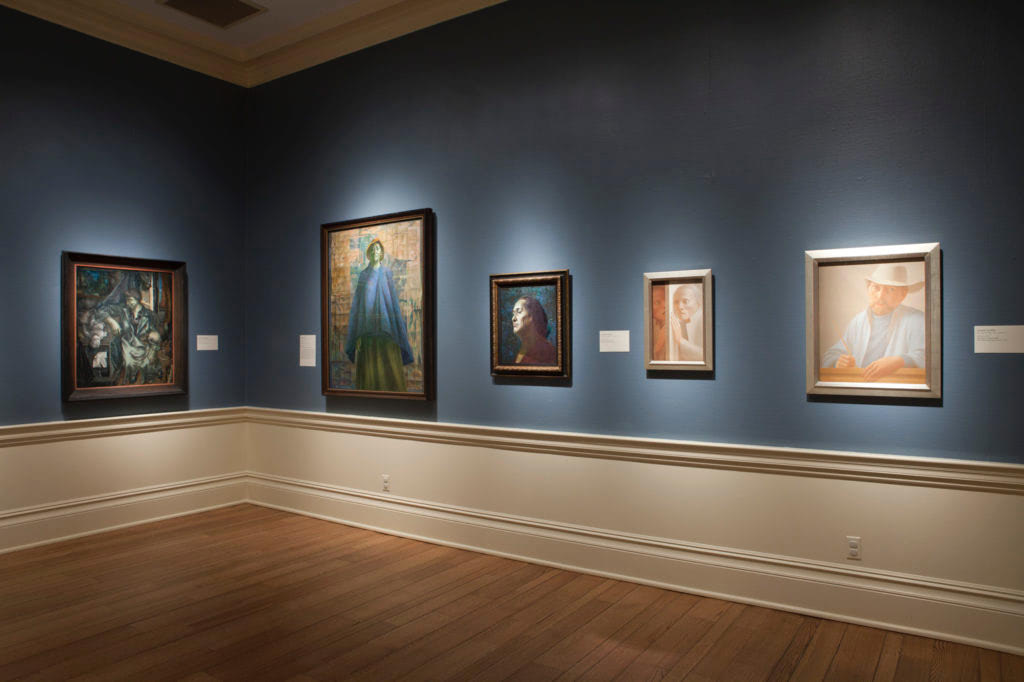Travelling exhibitions organized from permanent collections provide significant opportunities for object care, scholarly research, and institutional visibility. In the times in which we find ourselves, museums across the country are grappling with the complications and questions—financial, logistical, and interpretive—raised by the pandemic and the national movement for social justice. This is an occasion to mine our collections, casting new light on familiar works, and, perhaps most importantly, to create partnerships between museums that foster a deeper understanding among different regions of the country through the exchange of art.
In 2017, we began developing For America: Paintings from the National Academy of Design, a travelling exhibition and accompanying publication that presents work from the Academy’s significant holdings of art made in America. The idea was fairly simple: to present the Academy’s two submission rules—the first, issued in 1826 and still in effect today, of a “specimen of . . . one’s own production,” and the second, effective from 1839 to 1994, of a portrait of the artist, whether a self-portrait or one painted by a fellow artist—side-by-side to illustrate both the way painters view the world and the way they see themselves inhabiting that world. In this article, I explore some of the lessons I’ve learned while working on this tour, hoping they may spur thinking and encourage dialogue on the subject.
Distinct Audiences, Distinct Presentations
Every museum employs tailored visual languages to address their publics, so collaboration between the organizing institution and the presenting museum is essential. Local curators communicate things never clued by a floor plan or photographs: audience demographics, bottlenecks in visitor traffic patterns, opportunities for dramatic sightlines, and proven success stories for engaging audiences. This insider knowledge is invaluable for crafting a compelling presentation that speaks directly to visitors. For example, at the New Britain Museum of American Art, we presented ahistorical pairings to explore National Academicians’ shared painterly concerns across time; at Dixon Gallery and Gardens, we took a strict chronological approach which yielded new insights; and for the presentations of the Society of the Four Arts and the New Mexico Museum of Art, we’ve implemented Salon-style groupings to illustrate artists’ thematic experimentation.


Conservation Matters
Directors and donors are famously—and quite understandably—reticent to offer funding for conservation and framing of works to sit in storage when weighing institutional priorities, yet touring exhibitions often incentivize leadership and individuals to focus on the care of collection gems. Exhibition travel can put stress on objects and, in addition to constantly monitoring artworks while on the road, pre-tour preparation efforts such as conservation, framing, and glazing ensure the safety of objects from the start. Select preparation projects undertaken as a result of the national tour of For America included reframing John Singer Sargent’s self-portrait in a surrounding more consistent with the artist’s stylistic choices for commissioned portraits made during his lifetime; removing years of discolored varnish from Frederic Church’s quietly powerful Scene Among the Andes; and creating a microclimate to enclose a fragile work by George Inness composed of oil on paper mounted on panel.




New conservation efforts can also focus attention on once-overlooked masterpieces. For example, rather than submitting a likeness of himself to the Academy, Charles White offered Matriarch—a portrait of his great-aunt Hasty Baines, born into slavery in 1857 on the Yellowley plantation in Ridgeland, Mississippi—as his diploma portrait. Painted by White in 1967, 110 years after Baines’s birth, in the thick of a decade rife with political and social unrest, the deeply personal work stood for the artist as his intimate interpretation of the universal themes of wisdom and courage. After treatment, the work is on view for the first time in nearly four decades, and today, as ever, the colloquy between the portrait and his diploma work, Mother Courage II, is edifying.


In a New Light
Research and interpretation are ever-evolving processes. Travelling collection work to reach new audiences offers an opportunity to share fresh viewpoints on some of the collection’s most beloved works. To accomplish this, we invited current National Academicians, such as Catherine Opie and Fred Wilson, to select and write about individual works in the collection for the catalogue and the galleries’ interpretative texts. For example, artist Jaune Quick-to-See Smith, a member of the Confederated Salish and Kootenai Tribes of the Flathead Nation in Montana, responded to Albert Bierstadt’s On the Sweetwater Near the Devil’s Gate of 1860, which depicts a stretch of the Sweetwater River in present-day Wyoming. She reminds us that Bierstadt’s peaceful vision was contemporaneous with the Hellgate Treaty of 1855, which required the Native population to relinquish the northwest section of the state, part of Idaho, a piece of Canada, and half of Montana. As a result, many tribes were incarcerated at Fort Missoula, faced with starvation and smallpox. Such texts offer a window into the thinking of another individual. These words are a telling reminder that the art of this country means many things to many people, and that both the ideal and idea of America will constantly be investigated by its most advanced artists.


All artworks are in the collection of the National Academy of Design, NY.
The exhibit is on view at the New Mexico Museum of Art until January 17, 2021. For other venues and more information, click here.
For a behind the scenes glimpse into the exhibit when it was at The Society of the Four Arts in Palm Beach, Florida, view below:
Share this Article:
This article is intended for educational purposes only and does not replace independent professional judgment. Statements of fact and opinions expressed are those of the author(s) individually and, unless expressly stated to the contrary, are not the opinion or position of Tru Vue or its employees. Tru Vue does not endorse or approve, and assumes no responsibility for, the content, accuracy or completeness of the information presented.
